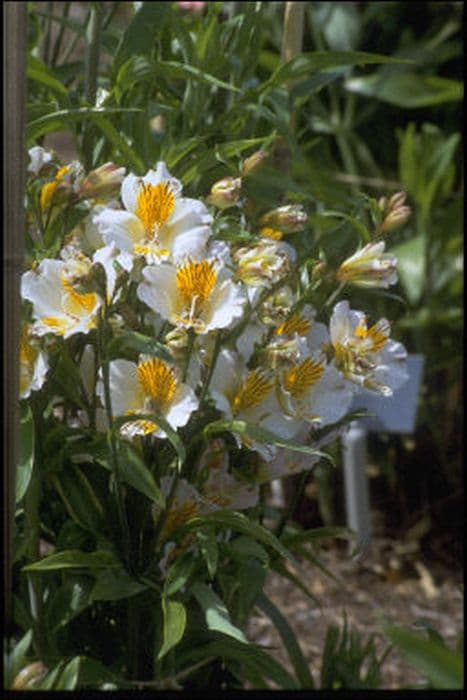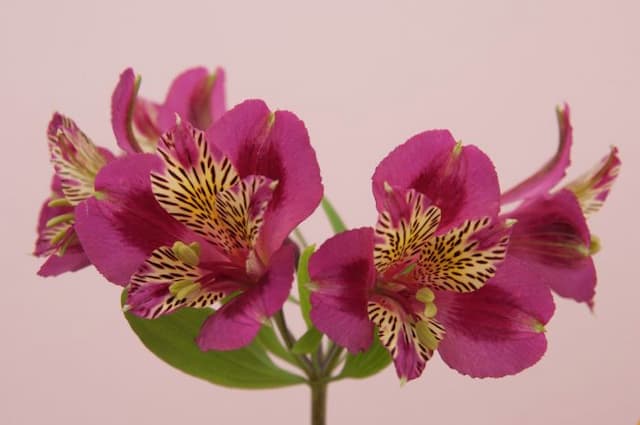Peruvian Lily Alstroemeria Inca Exotica = 'Koexotica' (Inca Series)
![Peruvian lily [Inca Exotica]](/_next/image?url=https%3A%2F%2Fplants-admin.emdemapps.com%2Fimages%2Fplants%2F%2Fimages%2F604b5ec0e34a9.png&w=3840&q=75)
ABOUT
The Alstroemeria Inca Exotica, commonly known as the Peruvian Lily or Lily of the Incas, is a vibrant and alluring perennial plant. It is characterized by its striking flowers that come in a blend of captivating colors. The blossoms exhibit a mix of deep purples and creamy whites, often with flecks or streaks of contrasting hues such as rich golds or dark browns. These intricate markings can resemble those of an exotic parrot's feathers, adding to the plant's exotic feel. The flowers are trumpet-shaped and grouped in clusters, each bloom composed of six flared and curved petals which give them a distinctive and symmetrical look. Upon closer inspection, one can often find a delicate dusting of tiny hairs on the petals, lending a subtle velvety texture to the blossom. This Peruvian Lily proudly displays its flowers atop strong, slender stems that are surrounded by lance-shaped, glossy green leaves. The foliage may have a slight twist or curl, giving the plant a lush and full-bodied appearance. The leaves themselves are quite elegant, adding a textural contrast to the soft and vibrant flowers. The overall impact of the Inca Exotica's blooms and foliage is one of exotic beauty and enticing color, making it a standout in any garden or bouquet.
About this plant
 Names
NamesFamily
Alstroemeriaceae
Synonyms
Inca Lily, Peruvian Lily, Lily of the Incas
Common names
Alstroemeria Inca Exotica = 'Koexotica' (Inca Series).
 Toxicity
ToxicityTo humans
The Peruvian Lily is generally considered non-toxic to humans, but it’s important to note that it can be a skin irritant for some individuals. While ingestion is not typically dangerous, it may cause mild stomach upset if large amounts are eaten.
To pets
The Peruvian Lily is considered mildly toxic to cats and dogs. If ingested, the plant can cause gastrointestinal upset, including symptoms like vomiting or diarrhea. It can also potentially cause mild dermatitis in some pets if they come into contact with the sap. Owners should keep an eye on their pets and consult with a veterinarian if any adverse reactions occur.
 Characteristics
CharacteristicsLife cycle
Perennials
Foliage type
Evergreen
Color of leaves
Green
Flower color
Orange
Height
2 feet [60 cm]
Spread
1 foot [30 cm]
Plant type
Herb
Hardiness zones
7
Native area
South America
Benefits
 General Benefits
General Benefits- Long-lasting blooms: Alstroemeria Inca Exotica is known for its colorful and long-lasting flowers, making it a popular choice for both garden display and cut flower arrangements.
- Vibrant color variety: The plant offers a range of vivid colors that can add a tropical flair to any garden or floral decoration.
- Attracts pollinators: This variety of alstroemeria attracts bees, butterflies, and other beneficial pollinators to the garden, supporting local ecosystems.
- Low maintenance: Alstroemeria Inca Exotica is relatively easy to care for, requiring minimal maintenance beyond regular watering and occasional feeding.
- Drought tolerance: Once established, it is quite drought-tolerant, making it suitable for gardens in drier climates or for gardeners seeking water-wise plants.
- Resilience to pests: It is generally resistant to pests, reducing the need for chemical treatments and making it a safer choice for the environment and pollinators.
- Adaptability: The plant can adapt to various soil conditions, though it prefers well-drained soils, making it versatile for different garden settings.
- Extended flowering season: Its flowering season is extended, often lasting from late spring through to autumn, providing extended beauty in the garden.
 Medical Properties
Medical PropertiesThis plant is not used for medical purposes.
 Air-purifying Qualities
Air-purifying QualitiesThis plant is not specifically known for air purifying qualities.
 Other Uses
Other Uses- Photography Prop: The vibrant colors of Alstroemeria Inca Series make them an excellent subject for botanical photography and macro photography.
- Eco-Friendly Confetti: Dried petals of Alstroemeria can be used as biodegradable confetti for celebrations, reducing environmental impact compared to traditional plastic confetti.
- Artistic Inspiration: Artists can use the intricate patterns and colors of the Alstroemeria flowers as inspiration for paintings, illustrations, and textile designs.
- Edible Cake Decorations: Although not commonly known as an edible flower, Alstroemeria petals can be used as non-toxic decorative elements on cakes and desserts, after ensuring they are free from pesticides.
- Dye Source: The pigments from the petals can be used to create natural dyes for fabrics, though they might not be as colorfast as synthetic dyes.
- Children's Crafts: The sturdy stems and vivid petals of Alstroemeria can be used by children to make bookmarks, greeting cards, or to practice flower arranging.
- Floral Baths: Petals of Alstroemeria can be added to bathwater for a luxurious, spa-like experience; they are not known for any skin benefits but can add an aesthetic appeal.
- Perfumery: While not commonly employed in the industry, Alstroemeria's subtle fragrance can contribute to homemade potpourri blends.
- Teaching Tool: The plant can be used in educational settings to teach students about plant biology, hybridization, and the care of ornamental plants.
- Pressing and Scrapbooking: The flowers can be pressed and used in scrapbooking or to create botanical prints for decorating home interiors.
Interesting Facts
 Feng Shui
Feng ShuiPeruvian lily is not used in Feng Shui practice.
 Zodiac Sign Compitability
Zodiac Sign CompitabilityPeruvian lily is not used in astrology practice.
 Plant Symbolism
Plant Symbolism- Friendship: Alstroemerias, also known as Peruvian Lilies, often symbolize strong bonds of friendship because of their twisted leaves that represent the ups and downs in relationships.
- Devotion: The Peruvian Lily is a symbol of a devoted love, as it suggests a willingness to support friends and family through challenges.
- Wealth: The abundance and variety of their colorful blossoms are associated with bringing prosperity and wealth.
- Achievement: This flower is often given to celebrate successes and achievements due to its luxurious appearance and long-lasting blooms.
- Fortune: Peruvian Lilies are believed to bring good luck, making them a popular gift for new ventures or to wish someone luck.
 Water
WaterPeruvian lilies should be watered regularly to keep the soil consistently moist but not soggy. During the growing season, water them once or twice a week by thoroughly soaking the soil with approximately 1 to 2 gallons for outdoor plants or around 16 to 32 ounces for potted plants, depending on size and environmental conditions. Reduce watering in the winter when the plant is dormant, ensuring the soil does not dry out completely. Always check the top inch of soil for dryness before watering again to avoid overwatering, which can lead to root rot.
 Light
LightPeruvian lilies thrive in bright, indirect light. They prefer a spot that receives plenty of light throughout the day but is shielded from the harsh midday sun, which can scorch their leaves. A location with morning sunlight and afternoon shade or filtered sunlight is ideal to encourage vibrant blooms and healthy growth.
 Temperature
TemperaturePeruvian lilies prefer a moderate temperature range and perform best when the temperature is between 55°F and 75°F. They can tolerate minimum temperatures down to around 28°F for short periods but are not frost-hardy, so they should be protected from freezing conditions. Maximum temperatures should not exceed 90°F for extended periods to prevent heat stress.
 Pruning
PruningPrune Peruvian lilies primarily to remove spent flower stalks and encourage reblooming. Deadheading, or cutting off the faded flowers, should be done regularly throughout the blooming season. Additionally, at the end of the growing season, remove any dead or damaged foliage to keep the plant healthy. The best time for major pruning is in late winter or early spring, just before new growth begins.
 Cleaning
CleaningAs needed
 Soil
SoilThe Peruvian Lily (Alstroemeria Inca Exotica) thrives best in fertile, well-draining soil with a pH range from 6.0 to 7.0. A mix containing loamy garden soil, peat, and perlite or sand can provide the balance of nutrients and drainage.
 Repotting
RepottingPeruvian Lilies should be repotted every two to three years to refresh the soil and accommodate their growing root system. It's best to repot in spring before the new growth starts.
 Humidity & Misting
Humidity & MistingPeruvian Lilies enjoy moderate humidity levels. They thrive when the relative humidity is around 40-60%, which is often the average indoor humidity range.
 Suitable locations
Suitable locationsIndoor
Place in bright, indirect light and keep at room temperature.
Outdoor
Plant in partial shade with shelter from intense midday sun.
Hardiness zone
7-10 USDA
 Life cycle
Life cycleAlstroemeria Inca Exotica, commonly known as Peruvian Lily or Lily of the Incas, starts its life cycle as a dormant rhizome, which upon planting in well-draining soil and with the right conditions, germinates and emerges as a seedling. The plant then enters a vegetative growth phase where foliage develops and the plant matures, establishing a robust root system. This is followed by the flowering stage, where buds develop and bloom into the characteristic colorful flowers, typically in late spring or summer. After pollination, which can be facilitated by insects, the plant may produce seeds that can disperse and lead to new plants, although many garden varieties are propagated vegetatively via division of the rhizomes. The Peruvian Lily's foliage often remains green throughout the growing season, but in colder climates, it may die back in the fall and become dormant during the winter months prior to resprouting in the spring. Commercially, vegetative reproduction is preferred to maintain the desirable traits of the 'Koexotica' variety, ensuring uniformity in cultivated plants.
 Propogation
PropogationPropogation time
Spring to Summer
The most popular method of propagating Alstroemeria, also known as Peruvian Lily or Lily of the Incas, is by division of the rhizome or tuberous roots. This method should be done in the early spring before the plants begin their active growth, or in the fall after the plants have finished blooming. Carefully dig up the plant, ensuring you have a good clump of tuberous roots. Gently tease apart the clumps into smaller sections, each with at least one eye, or growth point. Replant these divisions at the same soil depth as before, spacing them about 12 to 24 inches apart (approximately 30 to 60 centimeters). Water the newly planted divisions well to help establish them. This form of vegetative propagation ensures that the new plants will be true to the parent plant, maintaining the same flower colors and growth habits.





![Peruvian lily [H.R.H. Princess Alice]](/_next/image?url=https%3A%2F%2Fplants-admin.emdemapps.com%2Fimages%2Fplants%2F%2Fimages%2F604b55e81c8b0.png&w=640&q=75)

![Peruvian lily [Inca Coral]](/_next/image?url=https%3A%2F%2Fplants-admin.emdemapps.com%2Fimages%2Fplants%2F%2Fimages%2F604b5b79b85ce.png&w=640&q=75)
![Peruvian lily [Inca Milk]](/_next/image?url=https%3A%2F%2Fplants-admin.emdemapps.com%2Fimages%2Fplants%2F%2Fimages%2F604b5f14b0b6a.png&w=640&q=75)
![Peruvian lily [Inticancha Dark Purple]](/_next/image?url=https%3A%2F%2Fplants-admin.emdemapps.com%2Fimages%2Fplants%2F%2Fimages%2F604b5381bb78f.png&w=640&q=75)